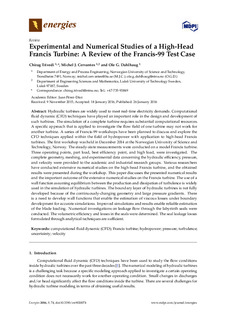| dc.contributor.author | Trivedi, Chirag | |
| dc.contributor.author | Cervantes, Michel | |
| dc.contributor.author | Dahlhaug, Ole Gunnar | |
| dc.date.accessioned | 2016-01-26T09:45:33Z | |
| dc.date.accessioned | 2016-03-10T09:02:13Z | |
| dc.date.available | 2016-01-26T09:45:33Z | |
| dc.date.available | 2016-03-10T09:02:13Z | |
| dc.date.issued | 2016 | |
| dc.identifier.citation | Energies 2016, 9(2) | nb_NO |
| dc.identifier.issn | 1996-1073 | |
| dc.identifier.uri | http://hdl.handle.net/11250/2381955 | |
| dc.description.abstract | Hydraulic turbines are widely used to meet real-time electricity demands. Computational fluid dynamic (CFD) techniques have played an important role in the design and development of such turbines. The simulation of a complete turbine requires substantial computational resources. A specific approach that is applied to investigate the flow field of one turbine may not work for another turbine. A series of Francis-99 workshops have been planned to discuss and explore the CFD techniques applied within the field of hydropower with application to high-head Francis turbines. The first workshop was held in December 2014 at the Norwegian University of Science and Technology, Norway. The steady-state measurements were conducted on a model Francis turbine. Three operating points, part load, best efficiency point, and high load, were investigated. The complete geometry, meshing, and experimental data concerning the hydraulic efficiency, pressure, and velocity were provided to the academic and industrial research groups. Various researchers have conducted extensive numerical studies on the high-head Francis turbine, and the obtained results were presented during the workshop. This paper discusses the presented numerical results and the important outcome of the extensive numerical studies on the Francis turbine. The use of a wall function assuming equilibrium between the production and dissipation of turbulence is widely used in the simulation of hydraulic turbines. The boundary layer of hydraulic turbines is not fully developed because of the continuously-changing geometry and large pressure gradients. There is a need to develop wall functions that enable the estimation of viscous losses under boundary development for accurate simulations. Improved simulations and results enable reliable estimation of the blade loading. Numerical investigations on leakage flow through the labyrinth seals were conducted. The volumetric efficiency and losses in the seals were determined. The seal leakage losses formulated through analytical techniques are sufficient. | nb_NO |
| dc.language.iso | eng | nb_NO |
| dc.publisher | MDPI - Open Access Publishing | nb_NO |
| dc.rights.uri | http://creativecommons.org/licenses/by/4.0/ | |
| dc.subject | computational fluid dynamic (CFD); Francis turbine; hydropower; pressure; turbulence; uncertainty; velocity | nb_NO |
| dc.title | Experimental and Numerical Studies of a High-Head Francis Turbine: A Review of the Francis-99 Test Case | nb_NO |
| dc.type | Peer reviewed | nb_NO |
| dc.type | Journal article | en_GB |
| dc.date.updated | 2016-01-26T09:45:33Z | |
| dc.rights.holder | This is an open access article distributed under the Creative Commons Attribution License (CC BY) which permits unrestricted use, distribution, and reproduction in any medium, provided the original work is properly cited. | nb_NO |
| dc.source.volume | 9 | nb_NO |
| dc.source.journal | Energies | nb_NO |
| dc.source.issue | 2 | nb_NO |
| dc.identifier.doi | 10.3390/en9020074 | |
| dc.identifier.cristin | 1322456 | |

